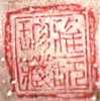Commenting is deactivated.
Please post all new topics and queries to the
Discussion Forum
Famille Rose Rooster Tureen
by Jefferson
(United States)

Chinese Export Famille Rose Rooster Tureen
To quote from the answer received per an inquirey made several years ago to Jan-Erik Nilsson of gotheborg.com -and viewable still at that website-with my photos (search: Rooster tureen with strange mark), As translated by, Mr. Simon Ng at the City University of Hong Kong.. the mark read(s) as 'Ya Wan? Zhen Chuang' (Delicate Collectable Precious Treasure). It is in Ng's opinion, a "modern piece art work mark or a seal for a collector's personal identification use."
Mr. Nilsson, himself, followed with his own comment: "This rooster is very interesting and of a remarkable integrity. From the looks of it I would not rule out a late Qing dynasty date for it, and a considerably value."
I certainly am grateful for both the time and effort afforded my question by these gentlemen but, clearly, I am left with a desire for, well, more actual factual information.
The statement, basically, that marks mean little is accepted whole heartedly by me-particularly because who can trust markings untranslatable by even the peoples who and for they were created. So;
Is my tureen 'modern'?
Is it Quing dynasty?
Is it 'considerably value'(sic)?
It it....well....wasting my time and, now, your time?
Thanks (or sorry)for your time.
-Jefferson
Comments for Famille Rose Rooster Tureen
|
||
|
||
|
||
|
||
|
||



